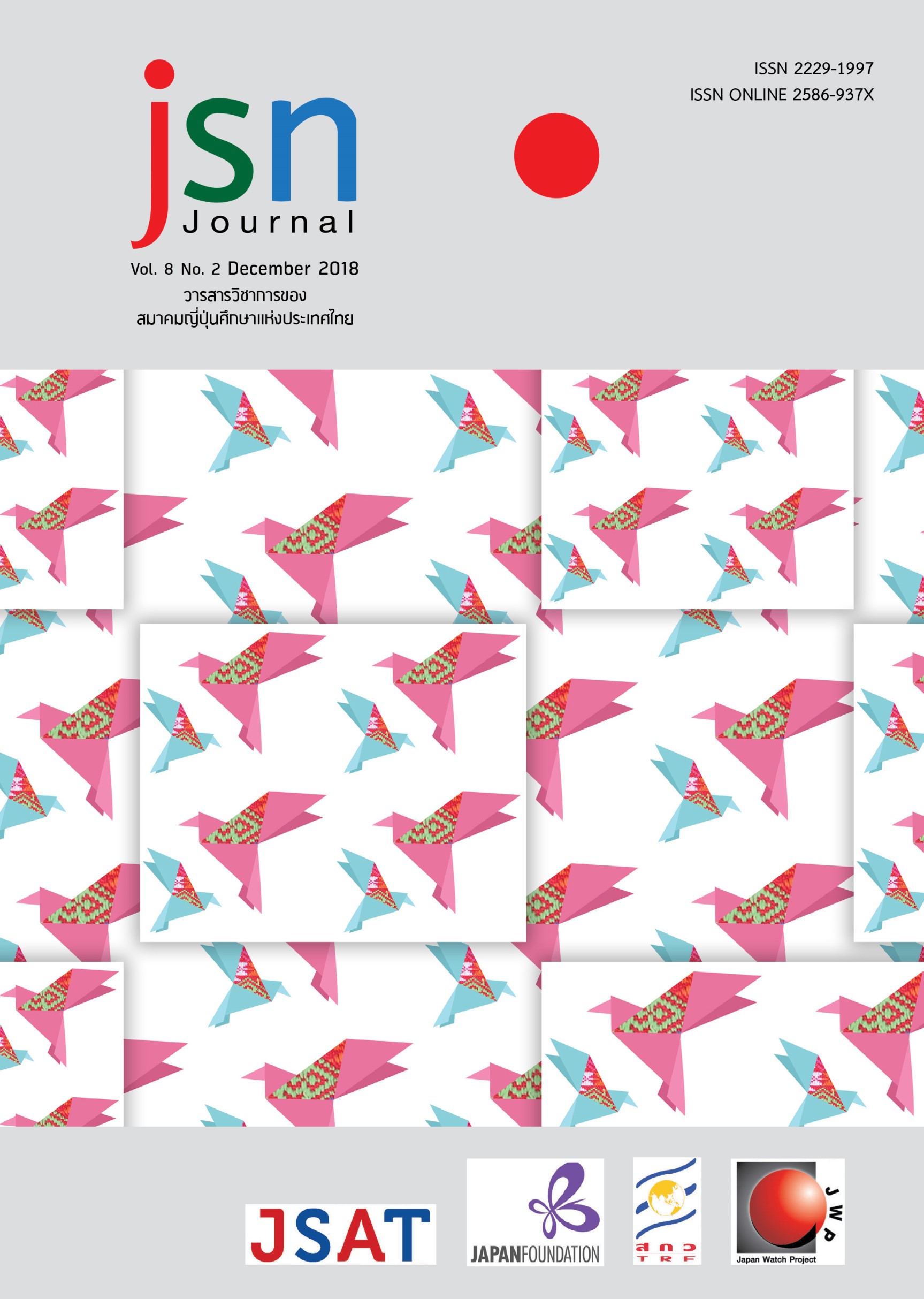The effects of lexical familiarity on the perception of Japanese consonants by Thai learners of Japanese
Main Article Content
Abstract
This paper presents the results of a preliminary study investigating the effects of lexical familiarity on the identification of the Japanese [ts] by Thai native speakers learning Japanese. The results showed that the degree of lexical familiarity can be shown to influence the degree to which Thai learners perceive accurately. Thai learners were better at identifying words of high lexical familiarity than words of low lexical familiarity and nonsense words. However, the results also indicated that inexperienced and experienced learners perform similarly at identifying the target sound. After years of learning, experienced learners still struggled with the contrast. Lastly, the findings of this study have relevance to theoretical issues in cross-linguistic speech perception. The pedagogical implications for Japanese pronunciation teaching and learning are also discussed.
Article Details
ข้อความและข้อคิดเห็นต่างๆ ในบทความเป็นของผู้เขียนบทความนั้นๆ ไม่ใช่ความเห็นของกองบรรณาธิการหรือของวารสาร jsn Journal
References
Amano, S. & Kondo, T. (2008). NTT database series nihongo no goitokusei [Lexical characteristics of Japanese]. Tokyo: Sanseido.
Cebrian, J. (2009) Exploring the roles of instruction and word familiarity in L2 vowel identification. Paper presented at the Phonetics Teaching & Learning Conference. Organised by University College London, UK.
Celce-Murcia, M., Brinton, D., & Goodwin, J. (2010). Teaching pronunciation: A course book and reference guide. New York, NY: Cambridge University Press.
Flege, J. E. (1995). Second language speech learning: Theory, findings, and problems. In W. Strange (Ed.), Speech perception and linguistic experience: Theoretical and methodological issues in cross-language speech research (pp. 233-277). Timonium, MD: York Press.
Flege, J. E., Takagi, N., & Mann, V. (1996). Lexical familiarity and English-language experience affect Japanese adults’ perception of /ɹ/ and /l/. Journal of the Acoustical Society of America, 99, 1161-1173.
Guion G. S., Flege, E. J., Yamada, A. R. and Pruitt, C.J. (2000). An Investigation of Current Models of Second Language Speech Perception: The case of Japanese Adults’ Perception of English Consonants. Journal of the Acoustical Society of America, 107, 2711-2744.
Lacabex, G. L. & Puerto, F. G. (2014). Raising perceptual phonemic awareness in the EFL classroom. Proceedings of the international symposium (COPAL). Volume 5, March 2014, pp 203-215.
Meyer, A & Schiller, N. (2003). Phonetics and phonology in language comprehension and production: Differences and similarities. Berlin: Mouton.
Pierce, R. L. (2014). Learning novel vowel contrasts: Experimental methods in classroom applications. (Doctoral dissertation, University of Illinois).
Schmidt, R. (2001). Attention. In P. Robinson (Ed.), Cognition and Second Language Instruction (Cambridge Applied Linguistics, pp. 3-32). Cambridge: Cambridge University Press.
Strange, W. (1995). Phonetics of second-language acquisition: Past, present, future. ICPhS 95, 4, 76-83.
Thomson, R. I. & Isaacs, T. (2009). Within-category variation in L2 English vowel learning. Canadian Acoustics, Vol. 37(3), 138-139.
Thomson, R. I. & Derwing, T. M. (2016). Is phonemic training using nonsense or real words more effective? Proceedings of the 7th Pronunciation in Second Language Learning and Teaching Conference, 88-97, Ames, IA: Iowa State University.
Trakantalerngsak, T. (2016). “The Effect of Perceptual Training on the Learning of Japanese Fricative and Affricate Contrasts by Native Thai Learners of Japanese” . (Doctoral dissertation, Osaka University).
Yamada, R., Tohkura, Y., & Kobayashi, N. (1992). Effect of word familiarity on non-native phoneme perception: identification of English /r/, /l/, and /w/ by native speakers of Japanese, in Second Language Speech, edited by A. James and J. Leather. Mouton de Gruyter, The Hague.
河野俊之 (2014).『音声教育の実践 (日本語教師のためのTIPS77 第3巻)』東京:くろしお 出版.
助川泰彦 (1993).「母語別に見た発音の傾向—アンケート調査の結果からー」『日本語音 声 と日本語教育』187-222.
タサニー・メーターピスィット(2014).「タイ人日本語学習者のための音声教育の現状と 課題―教師の教育方法と学習者の取り組み方を中心に」『早稲田日本語教育学』14-15-16, 87-104.
平岩ゆか (2004).「タイ人日本語学習者に対する発音指導のための基礎的研究」『Japanese Language Education Methods (JLEM)』 11(1), 10-11.
山川仁子・苣木禎史・宇佐川毅 (2005).「タイ人日本語学習者における破擦音ツの習得」『Proceedings of the auditory research meeting 』35(11), 663-668.


